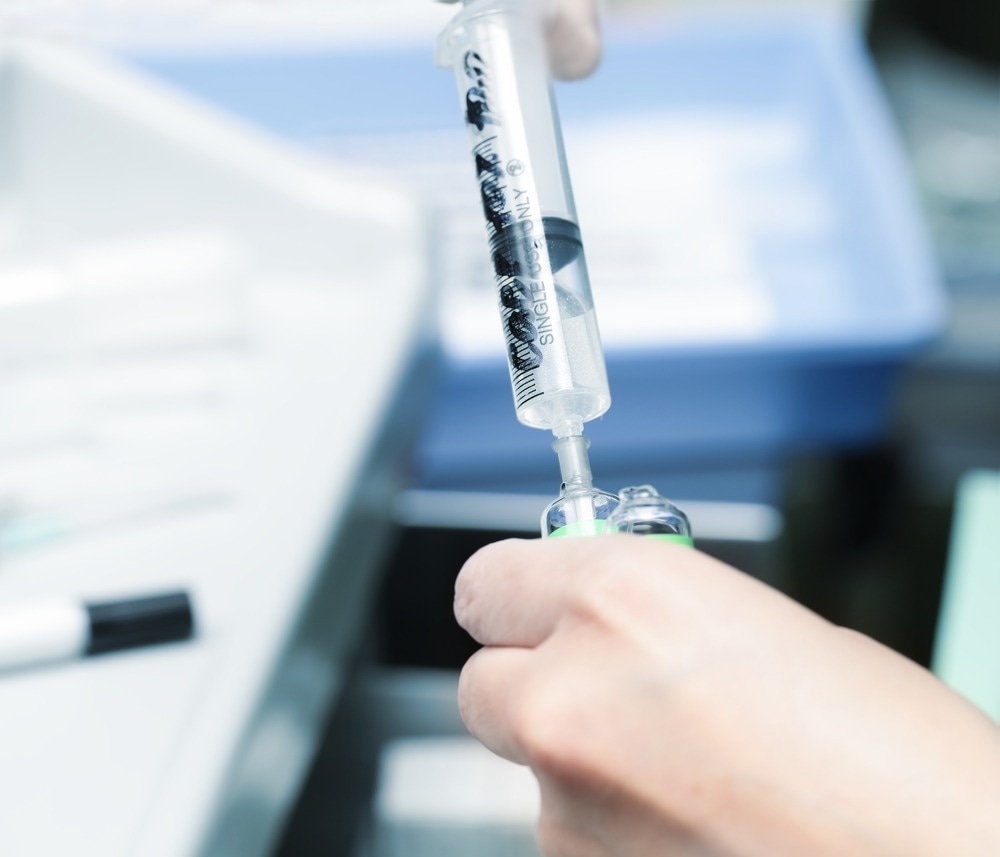Continue reading to learn more about the advantages and disadvantages of nanomedicine in this article.

Image Credit: Love Employee/Shutterstock.com
Nanomedicine deals with the application of concepts of nanotechnology to medicine.1 This approach promotes the development of personalized medicine, which has the potential to revolutionize medical practice. Compared to conventional and molecular medicine, nanomedicine has inherent advantages, such as precision and biocompatibility, along with certain disadvantages.
Nanomedicine - an Effective Treatment Strategy
An effective nanomedicine formulation is associated with developing novel nanoparticles with unique nanostructured surfaces. Nanomedicine has been applied in three different areas of medicine, i.e., diagnostics (nanodiagnosis), regenerative medicine, and controlled drug delivery (nanotherapy).2 In some cases, nanomedicines helped combine diagnostics and therapy; this concept has been termed theranostics. Theranostics is an emerging field that has recently gained significant attention.3
Many unmet medical needs have been fulfilled through nanomedicine. For instance, an effective exploitation of multiple mechanisms of action of nanoscale particles enabled the development of multifunctional nanogels. Nanoparticles exhibited improved bioavailability that has maximized effectiveness and reduced toxicity.4
The inherent nanoscale dimensions of nanomaterials have proved to be significantly advantageous for pharmaceutical developments. The unique size of the nanoparticle leads to an enhancement of the surface-to-volume ratio, which elevates the particle's surface energy. An increased surface energy augments the reactivity of the particle.5
In contact with biological fluids, nanomaterials are inherently capable of adsorbing biomolecules, such as lipids and proteins.6 The electrical, mechanical, optical, and magnetic properties of different nanoparticles have enhanced the applicability of nanoparticles as nanomedicines.
A notable capability of nanomedicine could be the functionalization of nanoparticles. Through functionalization, the properties of nanomedicines can be modified to realize desirable effects. Functionalization of nanomedicine can offer prolonged drug effects, target drug delivery, and identification of tumors or infected areas.7 Some key factors considered during the creation of targeted nanomedicine are particle size, biocompatibility, stability in blood, target affinity, and facilitation of controlled drug release.
To develop an effective nanomedicine, it is important to understand the physiopathological nature of the diseases and the interaction of the nanoparticle's surface with their immediate environment in biological fluid. As stated above, the functional groups present on the surface of the nanomaterial and biological components interact to promote medicinal functions.
Advantages of Nanomedicine
Some of the main advantages of nanomedicines are discussed below:
Disease diagnosis
Nanoscale sensors have enabled accurate disease diagnosis at a quicker pace. Advancements in imaging, such as such as computed tomography (CT) scans magnetic resonance imaging (MRI), and nanosensors have immensely helped detect biomarkers even at a very low level. These developments have helped early diagnosis of many diseases and has subsequently improved treatment prognosis.8
Targeted Therapy and Drug Delivery
One of the main advantages of nanomedicine could be its ability to deliver drugs at the targeted site.4 For instance, a nanoscale drug delivery system can specifically target cancer cells, preventing healthy cells from being eliminated. This process leads to lowering of side effects and increasing efficacy. Furthermore, the use of nano-based drug delivery systems has significantly improved the drug’s solubility, stability, and bioavailability.
Nanoparticles could be designed to target specific cells or tissues, such as cells with malignant growth, and deliver drugs upon reaching the targeted sites.9 The unique size of nanoparticles and nanodevices and their ability to interact with biological systems at a cellular and molecular level enables the formulation of targeted therapy.
Another advantage of nanomedicines is their ability to bypass biological barriers, such as the blood-brain barrier, and deliver drugs to the targeted site.10 At a cellular level, nanorobots can be used to deliver drugs or perform surgical procedures at sites that are difficult to access through conventional methods.

Image Credit: sfam_photo/Shutterstock.com
Personalized Medicine
As discussed before, nanomedicine has the potential to tailor treatments to a patient’s requirements. Essentially, it offers the possibility of patient-centered treatment. The targeted treatment approach could help minimize damage to healthy cells, maximize the drug's efficacy, and lower the overall drug’s toxicity.11
Regenerative Medicine
Nanomedicines can not only induce the generation of new tissues but also repair damaged cells. Nanofibers can help construct scaffolds required for tissue engineering, and nanocarriers can deliver growth factors and other essential molecules that enable tissue repair.12
Safety and Efficacy
Nanomedicine offers new opportunities to improve the efficacy and safety of conventional therapeutics. Particularly, drugs with low bioavailability could be efficiently targeted to specific regions, thereby improving therapeutic outcomes. The large surface-to-area ratio of nanomaterials could also reduce drug dosage to achieve effective results.9
Disadvantages of Nanomedicine
Despite having many advantages, there are some risks associated with nanomedicine applications. Some of the main disadvantages or risks associated with the use of nanomedicines are discussed below:
Toxicity
Most research on nanomedicine has focused on precise drug delivery; however, it is essential to understand the safety, pharmacokinetics, and toxicity of nanomaterials. Scientists face tremendous challenges in validating every nanotherapeutic agent.
At present, researchers and the US Food and Drug Administration (FDA) are struggling to develop guidelines for assessing the safety profiles and immunogenicity of nanotherapeutics. Establishing such guidelines is extremely important because of the risks involved in nanomedicine developing unexpected toxic effects due to the elevated reactivity of nanoparticles compared to bulk counterparts.13
Many studies have shown that nanotherapeutic agents can trigger hypersensitivity reactions because of the activation of the immune complement system. The toxic reaction of nanoparticles could be due to the induction of oxidative stress through forming free radicals. A high concentration of free radicals causes damage to DNA, protein, lipids, and other biological components.14
Regulatory Challenges
Newly formulated nanomedicines undergo strict regulatory approval phases before they can be used for diagnostic or therapeutic purposes in humans. These regulatory policies can slow down the development and implementation of new nanomedicines.15
Development Cost
The high manufacturing cost of nanoparticles could limit their availability.
Limited Information
More research is required for comprehensive elucidation of the interactions between nanoparticles and the human body. These studies must focus on the potential risks and benefits of nanomedicines.
Future Perspectives
Nanomedicines have tremendous potential to combat many long-standing issues of medical research, including poor drug solubility and lack of targeted efficiency. It holds significant promise as a non-invasive tool for tumor detection, diagnostic imaging, and drug delivery because of its optical, magnetic, and structural properties.
In the future, scientists must develop a universally accepted definition of nanomedicines. Furthermore, complete regulatory guidelines for the development, characterization, and assessment of nanomedicine must be formulated.
References and Further Reading
- Ventola CL. The nanomedicine revolution: part 1: emerging concepts. P T. 2012;37(9):512-525.
- Soares S. et al. Nanomedicine: Principles, Properties, and Regulatory Issues. Front Chem. 2018; 6, 356901.
- Siddhardha B, Parasuraman P. Theranostics application of nanomedicine in cancer detection and treatment. Nanomaterials for Drug Delivery and Therapy. 2019; 59-89.
- Afzal O, Altamimi ASA, Nadeem MS, et al. Nanoparticles in Drug Delivery: From History to Therapeutic Applications. Nanomaterials (Basel). 2022;12(24):4494.
- Vollath D, Fischer FD, Holec D. Surface energy of nanoparticles - influence of particle size and structure. Beilstein J Nanotechnol. 2018;9:2265-2276.
- Muraleetharan V, Mantaj J, Swedrowska M, Vllasaliu D. Nanoparticle modification in biological media: implications for oral nanomedicines. RSC Adv. 2019;9(69):40487-40497.
- Popescu RC, Andronescu E, Vasile BS. Recent Advances in Magnetite Nanoparticle Functionalization for Nanomedicine. Nanomaterials (Basel). 2019;9(12):1791.
- Thwala LN, Ndlovu SC, Mpofu KT, Lugongolo MY, Mthunzi-Kufa P. Nanotechnology-Based Diagnostics for Diseases Prevalent in Developing Countries: Current Advances in Point-of-Care Tests. Nanomaterials (Basel). 2023;13(7):1247.
- Yusuf A, Almotairy ARZ, Henidi H, Alshehri OY, Aldughaim MS. Nanoparticles as Drug Delivery Systems: A Review of the Implication of Nanoparticles' Physicochemical Properties on Responses in Biological Systems. Polymers (Basel). 2023;15(7):1596.
- Riehemann K, Schneider SW, Luger TA, Godin B, Ferrari M, Fuchs H. Nanomedicine--challenge and perspectives. Angew Chem Int Ed Engl. 2009;48(5):872-897.
- Fornaguera C, García-Celma MJ. Personalized Nanomedicine: A Revolution at the Nanoscale. J Pers Med. 2017;7(4):12.
- Arora P, Sindhu A, Dilbaghi N, Chaudhury A, Rajakumar G, Rahuman AA. Nano-regenerative medicine towards clinical outcome of stem cell and tissue engineering in humans. J Cell Mol Med. 2012;16(9):1991-2000.
- Khare V, Saxena AK, Gupta PN. Toxicology Considerations in Nanomedicine. Nanotechnology Applications for Tissue Engineering. 2015; 239-261.
- Alsaleh NB, Brown JM. Engineered Nanomaterials and Type I Allergic Hypersensitivity Reactions. Front Immunol. 2020;11:222.
- Thapa RK, Kim JO. Nanomedicine-based commercial formulations: current developments and future prospects. J Pharm Investig. 2023;53(1):19-33.
Disclaimer: The views expressed here are those of the author expressed in their private capacity and do not necessarily represent the views of AZoM.com Limited T/A AZoNetwork the owner and operator of this website. This disclaimer forms part of the Terms and conditions of use of this website.